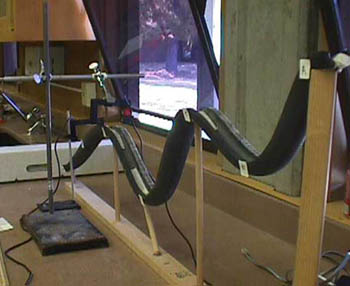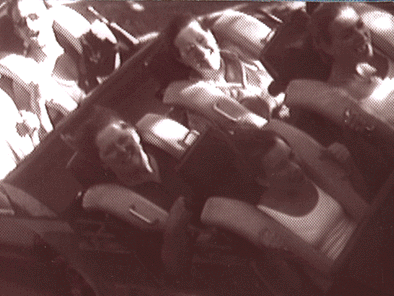
The Model Roller Coaster Physics Project
Background: Many physics classes visit amusement parks to study the principles of physics used in the various rides. This lab can be part of a group roller coaster construction project.
Setup Materials:
Vernier ULI interface
Two Pasco photogates
Track section made from pipe insulation, wooden dowels, and wooden stand. Other possible track section construction materials are: aluminum channel or angle material, clear plastic hose, toy car tracks, or building sets.
Golf Ball

Procedure:
1. Set up the track, the ULI and the photogates.
2. Mark several areas on your track. Use the two gate timing mode from Logger Pro. (Hints: The object must pass through both gates or the program does not work It must go through photogate one first or it will not take data.) Be sure to check the diameter of the object that you are using and enter it into the experimental setup so that the velocity data is correct.
3. Determine and record the mass of the ball.
4. Release the ball from the same point each time. Run ten trials for each photogate location. Use the measurement option in data logger. This will allow you to take the average velocity for each point on the track.
Data: Record your data in the following spreadsheet. Put the initial height of the ball in cell A2. Put the mass of the ball in cell A5. Put the heights of the measurement locations in cells C2 etc. Please note in the sample data that no velocity measurement were taken at point E.
Sample Model Coaster Spreadsheet.xls
Sample Model Coaster Spreadsheet with Data.xls
Questions:
1. Compute the total energy at each point of the model coaster.
2. Explain the changes in energy between points D and F. ( Note that the photogates are on points E and F.)
3. Compare and contrast the model roller coaster and a real roller coaster.
Other Extensions of this lab: Build other sections of the roller coaster ride: compare a round loop and a clothoid loop; horizontal spirals; vertical spirals; etc.. The sections from one class could be combined into one coaster.
WWW Resource Sites:
1. This is a web site for the roller coaster corporation of America. http://www.rcca.com/
2. This is a web site for roller coaster designers. http://www.coasters.net/designers/
3. This is a web site for the American coaster enthusiasts group. http://www.aceonline.org/
4. This is a good reference website. http://www.learner.org/exhibits/parkphysics/coaster.html
5. This is an individual's website. http://hale.pepperdine.edu/~bsouza/coasterURLs.htm
6. This a group's website: http://www.rollercoaster.com/
Resource References: These were gathered from the database of articles from The Physics Teacher and the American Journal of Physics found at http://www.phy.nau.edu/~danmac/AAPTDB/
1. Robert R. Speers, "Physics and roller coasters_The Blue Streak at Cedar Point, "American Journal of Physics, Vol. 59, No. 6, June 1991 Pages 528 - 533
2. Dale R. Blaszczak, "The roller coaster experiment," American Journal of Physics, Vol. 59, No. 3, March 1991 Pages 283 - 285
3. Robert Speers, "Perspectives on the world's tallest roller coaster,"The Physics Teacher, Vol. 30, No. 4, April 1992 Pages 216 - 217
4. This is the article that inspired me to assign the roller coaster project to my students.
Roberta R. Tanner, "Roller-coaster design project," The Physics Teacher, Vol. 35, No. 3, March 1997 Pages 148 - 149
Students design and make scale models of roller coasters. Acceleration must not exceed 5 g’s and normal force must not go below 0 newtons. Students must integrate concepts of free-body diagrams, net force, normal force, circular motion, and conservation of energy.
5. John L. Roeder, "Physics and the amusement park," The Physics Teacher, Vol. 13, No. 6, September 1975 Pages 327 - 332
6. Kim Natale, "Final exam in an amusement park," The Physics Teacher, Vol. 23, No. 4, April 1985 Pages 228 - 228
7. Barbar Wolff , "Amusement park physics," The Physics Teacher, Vol. 26, No. 9, December 1988 Pages 555 - 555
8. Carole Escobar, "Amusement park physics," The Physics Teacher, Vol. 28, No. 7, October 1990, Pages 446 - 453
9. Amusement Park Physics, edited by Carole Escobar, published by AAPT, ISBN#0-917853-53-9
Experiment by

Nina M. Morley, Orange High School, 500 Orange High Road, Hillsborough, NC 27278
919-732-6133 ext. 3314, morleyn@ohs.orange.k12.nc.us